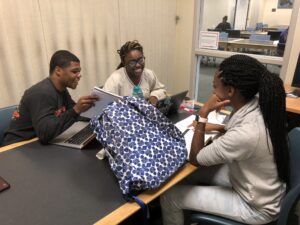
Group projects — some college students cringe at the thought, others welcome them.
Over the years, students have openly expressed their opinions on group projects in college through case studies, surveys, social media posts and word-of-mouth. Students at Florida A&M University are not excluded.
FAMU students took to Twitter recently and expressed their concern for the appropriateness of group projects in college.
One student tweeted, “Why are we still doing group work in college? I hate it.”
With retweets, likes and comments giving this message an amen, it is clear this concern is not foreign to the campus of FAMU.
A sophomore architecture major, Zaquahyia Haugabrook, believes one of the most gruesome tasks during a group project is scheduling meet-ups with classmates running on different agendas.
“When everyone doesn’t have the same schedule, it makes it difficult,” Haugabrook said.
It is common for college students to work and participate in extra-curricular activities outside of class. Haugabrook says this is typically the wedge that stands between completing a group-assigned project in a timely, organized manner.
According to a 2016 case study conducted at Embry–Riddle Aeronautical University in Daytona Beach, participation is regarded as the most commonly talked about issue by college students. Students are often burdened with a group-mate who does not contribute enough or, in some cases, at all.
Codi Gray, a sophomore biology pre-med major, says when people don’t want to help work and participate it is stressful, especially with access to modern technology that enables communication at the tap of a finger. Her remedy is to consult with a professor immediately.
A senior food science major, Alexandra Reid, takes a similar approach to group projects.
“When I’m assigned to a group I immediately devise a backup plan in case everyone doesn’t pull their weight. I have no problem alerting my professor if it gets bad,” Reid said.
Vashti Jenkins-Taylor, a writing consultant from FAMU’s Writing Resource Center, says that group-work builds confidence and allows room for innovative idea exchange when students are actively engaged. Her advice to any student involved in a group project is to listen.
“If you’re working with another person and they have good ideas, but you’re not listening, you’re going to come to a roadblock,” Jenkins-Taylor said.
She challenges students to create a social dynamic that gives everyone the opportunity to want to actively participate in the project.
In a 2017 case study at the University of Washington, researchers found that “social dynamics affect student performance on group projects.” In other words, the more comfortable students are, the better off they will be.
Jenkins-Taylor believes it is the sense of community among students who collaborate on projects that invites warmth and spontaneity.
“If you could really get a group going you start to hear a lot of unexpected things, especially in a semi-formal environment because once you’re able to break that initial nervousness, people start to think really hard because they’re expecting a lot of themselves,” Jenkins-Taylor said.
Israel Salazar, a senior music industry major, appreciates the collaborative process required of group projects because it often produces new ideas.
“I like exchanging ideas with others because I always run into other cool ideas that I probably would not have thought about on my own,” Salazar said.
A senior healthcare management major, Nadia Hatfield, believes the more communication there is in a group, the better.
“It feels good when my group communicates with me and vice versa,” Hatfield said. “I feel like more gets done when we all have in our heads who’s doing what and how.”
Group projects are challenging by design, but are great tools to practice professional development skills such as leadership, preparation, problem-solving and communication — which is why they are often used as teaching aids in collegiate settings across the globe.